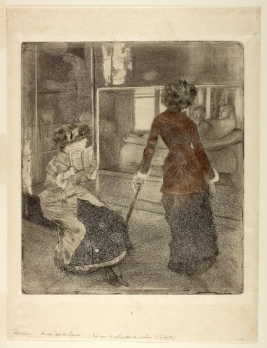Degas’s own planned contribution for the failed journal Le Jour et la nuit was the etching now known as Mary Cassatt at the Louvre: The Etruscan Gallery. Cassatt once remarked that she posed for Degas “only once in a while when he finds the movement difficult and the model cannot seem to get his idea.” Yet the theme of Cassatt strolling through the Louvre clearly fascinated him, resulting in a rich body of work produced in a range of media over a number of years. Encompassing two prints, at least five drawings, a half-dozen pastels, and two paintings, the series marks one of Degas’s most intense and sustained meditations upon a single motif.
Mary Cassatt at the Louvre

Edgar Degas, Mary Cassatt at the Louvre: The Etruscan Gallery, 1879–1880, softground etching, drypoint, aquatint, and etching, retouched with red chalk, The Art Institute of Chicago, Albert Roullier Memorial Collection. Photography © The Art Institute of Chicago
Degas’s choice of the Louvre as the setting for this group of works spoke to the two friends’ mutual appreciation for art and its tradition. In the series, he depicted Cassatt as an elegantly dressed museum goer, wholly absorbed in her study of art. Nearby, a seated companion (usually identified as Cassatt’s sister Lydia) looks up from her guidebook. Cassatt, with her back turned fully to the viewer, balances against an umbrella in a pose that highlights the curve of her body and underscores her air of assurance. Although the precise relationship between the various works is not entirely certain, Degas most likely began with drawings and pastels of individual figures that served as references for the series as a whole. The more elaborate pastels and paintings of women visiting a museum culminate the series.
